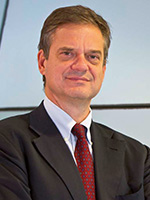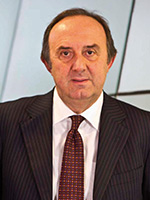Letter to the shareholders and stakeholders

To our Shareholders and Stakeholders,
In 2014, Snam once again posted good results, despite the ongoing economic crisis, temporary factors related to weather conditions and, in particular, a fall in consumption in the thermoelectric sector, which resulted in a decrease in gas consumption in Italy for the fourth consecutive year. Domestic demand for gas fell from 83.10 billion cubic metres in 2010 to 61.94 billion cubic metres in 2014 (similar levels to those recorded in the late 1990s), a reduction of 25.5% since 2010 that will be difficult to absorb in the short term.
In this context, with falling domestic production and a high dependency on imported gas, Snam focused its development strategy on interconnection capacity and the integration of European gas networks, in line with the long-term strategy recently outlined by the European Union. These objectives drive our development and represent a necessary challenge in order to guarantee secure supplies and greater liquidity within the gas system, which is essential if Italian gas prices are to be structurally aligned with those of the major European countries.
In light of this, in addition to further upgrading gas infrastructure in Italy as part of a wider initiative to facilitate interconnection between European networks, in 2014 Snam completed a major international transaction of strategic importance for our country. December 2014 saw the completion of Snam’s acquisition of 89% of the economic rights in Trans Austria Gasleitung GmbH (TAG) in exchange for an amount of €505 million, settled through a capital increase by Snam. TAG owns the Austrian section of the gas pipeline that runs from Russia to Italy via Ukraine, Slovakia and Austria, which is expected to satisfy the majority of Italy’s gas import requirements.
The transaction, which follows the recent acquisition of a 45% stake in France’s TIGF and a 31.5% stake in Interconnector UK as part of a joint venture with Belgian firm Fluxys, as well as the signing in early 2014 of a memorandum of understanding with Fluxys with a view to pursuing opportunities for growth in Europe, will strengthen the group’s position as one of Europe’s leading infrastructure operators. Snam now has a new key asset in the East-West energy corridor, including in terms of potential reverse flow to central Europe.
Snam also pursued the measures it began in 2013 to improve its financial structure and align it with business needs in terms of loan terms and interest rate exposure, with significant results in reducing the overall cost of borrowing. At 31 December 2014, fixed-rate debt represented 69% of total financial debt, compared with 49% at the end of 2012 and 64% at the end of 2013; bond issues accounted for 76% of debt. Snam placed new bonds worth a total of €1.7 billion in 2014, providing further proof of international investors’ confidence in our business model.

Lorenzo Bini Smaghi
Chairman

Carlo Malacarne
CEO
Thanks to our continual focus on operating and financial efficiency, we were again able to achieve strong results in 2014, which is even more impressive given that it was the first year of the new (fourth) regulatory period for the natural gas transportation, regasification and distribution segments. EBITDA and EBIT totalled €2,776 million and €1,973 million respectively, more or less in line with the previous year. Net profit was €1,198 million, up 30.6% compared with 2013. This increase was due mainly to the fall in income taxes as a result of the adjustment to deferred taxes following the recent declaration of the unconstitutionality of the additional corporation tax known as the “Robin Hood Tax” levied on the natural gas transportation and distribution segments, as well as improved financial management and the contribution from assets recognised as part of the business development strategy.
Snam shares closed 2014 at an official price of €4.11, up by 1.9% compared with the price of €4.04 recorded at the end of the previous year, a greater increase than that of Italy’s FTSE MIB share index (+0.2%). This reflects investors’ confidence in the Company’s solid fundamentals and its capacity to generate sufficient operating cash flows to cover the financial requirements for planned investments and to support an attractive dividend policy, in line with the group’s strategic plan.
In 2014, Snam’s stock, which was already listed on the world’s biggest sustainability indices, including the Dow Jones Sustainability World Index, the FTSE4Good Index, the Climate Disclosure Leadership Index (CDLI) and the various ECPI and Vigeo indices, joined the MSCI indices and the United Nations Global Compact 100 (GC 100), which represents the 100 companies that stand out most worldwide in terms of both attention to sustainability issues and financial performance. Snam is one of only five Italian companies on the GC 100.
With reference to the values that form the basis of the group’s strategy and corporate conduct, Snam’s achievements in 2014 included winning a “Financial Statements Oscar” in the “Listed Companies and Large Businesses” category. This recognition represents further confirmation of the effectiveness of the group’s reporting model and of the numerous communication and stakeholder relations tools used, from the Annual Report to the Sustainability Report, and from the Remuneration Report to the Report on Corporate Governance.
In a changing energy context and with the challenges Snam is preparing to tackle over the next few years, it is essential that we pay careful attention to the evolving situation of gas markets and the energy sector in general. Snam’s sizeable investment plan, which is intended to upgrade Italy’s gas infrastructure in line with the system’s needs whilst simultaneously pursuing international development, aims to promote ever deeper integration of European networks and to consolidate Snam’s role as one of the continent’s leading integrated operators. To pursue this goal, Snam must take further steps to strengthen its role as a facilitator of the gas system in order to develop and provide integrated services, through the coordinated use of different infrastructures that can satisfy customers’ service needs in terms of both flexibility and logistics.
11 March 2015
for the Board of Directors
The Chairman

The CEO
